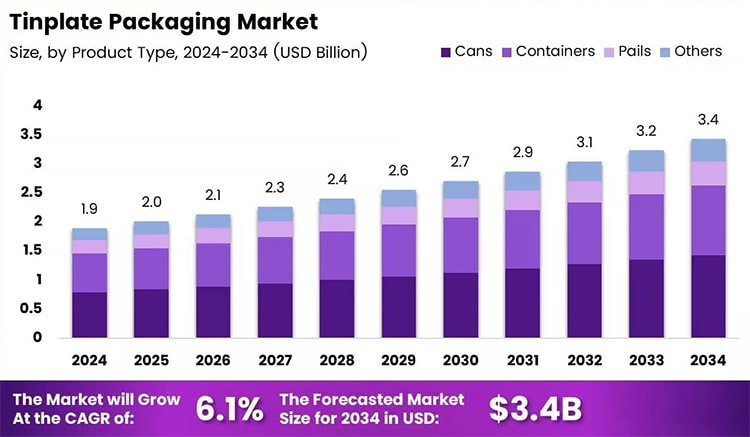
The global tinplate packaging market is experiencing a major shift fueled by increasing environmental awareness and consumer demand for recyclable alternatives. According to recent analysis, the market size is projected to rise from USD 605.7 billion in 2024 to a remarkable USD 948.9 billion by 2034, with a compound annual growth rate (CAGR) of 4.6%.

Tinplate—formed by coating thin steel sheets with a layer of tin—has emerged as a sustainable packaging solution due to its high recyclability and long-standing industrial use.
As regulatory pressures around the globe mount and eco-conscious consumers demand greener solutions, tinplate is proving more economical in the recycling loop compared to traditional materials like plastic. For instance:
| Material Type | Recycling Cost (per ton) | Recycling Efficiency |
|---|---|---|
| Tinplate | £140–£180 | Over 75% |
| Plastic | £225 | Below 40% |
In the UK alone, more than 10.7 billion tins and cans were recycled in 2023, showcasing a significant adoption of metal recycling practices. Countries like Germany, South Korea, and Japan continue to lead in metal packaging reuse, often exceeding 80% recycling rates.
Major corporations are increasing their focus on sustainability. The Metal Packaging Manufacturers Association (MPMA) and global packaging firms are actively investing in improving the design, light-weighting, and energy efficiency of tinplate products.
Innovative design techniques—such as improved sealing methods and custom printing—have opened new avenues in cosmetics, food & beverage, and pharmaceuticals.
Different industry segments are contributing to the upward trajectory of tinplate packaging demand:
| Application Sector | Key Benefits of Tinplate Use | 2024 Market Share |
|---|---|---|
| Food & Beverage | Preserves freshness, long shelf life | 46% |
| Cosmetics | Elegant finish, protective coating | 21% |
| Household Chemicals | Leak-proof, corrosion-resistant | 17% |
| Others | Diverse use (candles, gifts, etc.) | 16% |
This wide range of applications, coupled with increasing urbanization and changing consumer behavior, is expected to fuel continued demand across both developing and developed markets.
While the global outlook remains positive, the market faces some hurdles such as:
That said, Asia-Pacific remains the dominant region, accounting for over 49.7% of global consumption, followed by Europe and North America.
With robust demand drivers, ongoing innovation, and regulatory backing for sustainability, tinplate packaging is well-positioned to continue its growth over the next decade. Its ability to blend durability, design flexibility, and recyclability makes it a valuable packaging material for industries seeking to align with environmental targets.
As consumers and governments alike push toward greener economies, tinplate offers a time-tested and cost-effective path forward.